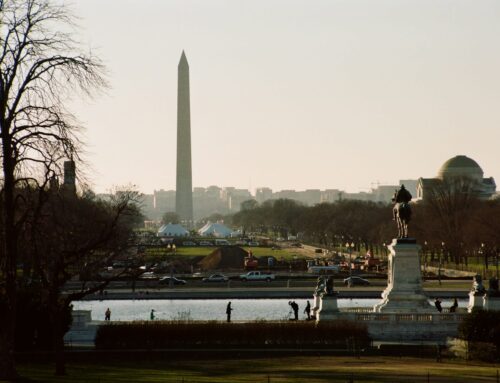Good morning Chairman Costa, Ranking Member Pearce, members of the Subcommittee. Thank you for inviting me to testify this morning on H.R. 2262, The Hardrock Mining and Reclamation Act of 2007. I am Steve Ellis, Vice President of Taxpayers for Common Sense, a national non-partisan budget watchdog group.
Since its inception in 1995, TCS has pushed for reform of the 135-year old General Mining Law of 1872. However, we are not advocating modernizing simply because it is old. After all, our constitution is well over 200 years old, and we all think that it is a very fine document. However, we have amended the Constitution 27 times over the years for good reason. The Mining Law of 1872 is a relic of an entirely different era, and it is high time it is amended to reduce its exorbitant taxpayer subsidies.
Subsidies are simply a tool to encourage behavior that would otherwise not necessarily occur. The subsidies in the Mining Law of 1872 were intended as an incentive to populate the West and encourage economic development and production that Congress and President Grant believed would not otherwise occur. H.R. 2262 recognizes that the law is an anachronism, and now it is time to ensure that taxpayers aren’t forced to pick up the tab.
Taxpayers for Common Sense supports H.R. 2262 as a strong step toward reigning in the excesses of the Mining Law of 1872. I will detail some of these excesses and describe how H.R. 2262 addresses them.
Under the Mining Law of 1872, corporations can stake claims on federal land for an annual maintenance fee of $125 per acre plus an additional $30 location fee and $15 new mining claim service fee for first timers.[1] These fees generated $47.5 million and $32.3 million in revenue in FYs 2005 & 2006 respectively.[2]
According to law, the claimant can “patent” or purchase the claim for either $2.50 or $5.00 per acre.[3] Just to put that in perspective the 2006 purchasing power of $2.50 from 1872 is just 15 cents. $5.00 is 31 cents.[4] That’s how little we are valuing taxpayer’s property. A few examples:
- In Crested Butte, Colorado the federal government sold 155 acres to the Phelps Dodge mining company for approximately $790, despite a company estimate that the land could produce up to $158 million in after-tax profits over 11 years. This is in an area where prices range as high as $1 million per acre.
- In Nevada, in 1994, American Barrick paid $9,765.00 for 1,950 acres that contained an estimated $10 billion in gold.
In some cases, it appears that mining patents have been little more than a ruse for developers to get their hands on valuable federal property and then flipping it for other, more lucrative uses. A few examples:
- In 1983, the Forest Service sold 160 acres near the Keystone, CO ski resort for $400. Six years later he sold it for $1 million.
- In 1970, a businessman bought 61 acres for $153. Just ten years later he sold it to a developer for $400,000 pus an 11% share in future profits.
In FY1995, Congress began enacting one-year patent moratoriums. Patent applications that were in the pipeline have been grandfathered, but new patents have not been issued. However, continuing the decade of one-year extensions makes little sense for either the mining industry or taxpayers. H.R. 2262 rightly throws patenting of federal land onto the ash heap of history. The Congressional Research Service points out a critical fact to remember, ending the practice of patenting “will not stop the production of valuable mineral resources from the public lands, but will prevent the further transfer of ownership of public lands to the private sector.” Transfer of public lands to the private sector at bargain basement prices should be stopped permanently.
Gold and Other Valuable Minerals for Free
After charging a pittance for the land, the Mining Law of 1872 essentially ignores that mining is all about recovering valuable minerals from the land. Despite the fact that the private sector extracts public assets from ground, the taxpayer receives no compensation whatsoever. Since enactment of the mining law, the total value of minerals that have been taken without compensation is an estimated $245 billion. That’s the equivalent of emptying Fort Knox of all its gold two and a half times over.[5]
By comparison, the oil and gas industry generally pays 12.5% in royalties on what they extract onshore.[6] States are smarter than the federal government as well, with many of them requiring royalties for mining on state lands.
H.R. 2262 requires an 8% royalty on net smelter returns. Net smelter return is essentially the gross revenue for the mineral product that the mine receives from a refinery or smelter. This ensures that the royalty automatically adjusts to changes in the market and does not over- or undercharge. TCS is aware that there are other proposals out there such as net revenue or net profits royalty. These offer too much opportunity of gamesmanship on what the deductible costs will be. I am reminded of naïve film investors that agree to take a share of the profits – after the expenses, there are no profits.
Mineral Business Appraisal, self-described geologic and mining experts in the appraisal of all types of mineral property, describe net profits royalty, indicating “[t]here are virtually no buyers for this type of royalty because of the creative accounting that the mining operator can use to depress the royalty payment amount. The distinguishing feature of a net profits royalty is that, depending upon the exact definitions in the mining lease and the actual calculations, it will very often be zero.”
According to Mineral Business Appraisal, net smelter “royalty payments are also fairly simple to calculate and administer in that only the selling price and quantity of mineral product produced or sold are required for their determination.” In addition, “this type of royalty will usually have the highest market value of all the royalty types.”[7] Simple, predictable and valuable, that sounds like it is in the taxpayer’s interest.
One significant change Taxpayers for Common Sense would like to see in H.R. 2262 royalty structure is to increase the payment to 12.5%, which would be more commensurate with other extractive industries. A key point to remember is that although this is higher it is still based on current markets and still a very small share of the gross return.
All too often, after all the minerals have been removed, mining operations have been splitting town, leaving communities with a mess and taxpayers holding the bag to pay for clean up. A 2004 report by the U.S. Environmental Protection Agency (EPA) Inspector General indicated that the Superfund National Priority List contained 63 hardrock mining sites and another nearly 100 sites could be added in the future. The price tag for cleaning up all of these sites was $7 – $24 billion, with more than half likely to be stuck on taxpayers. Because clean-up takes such a long time, it is likely that some of the businesses currently on the hook will no longer remain viable and the taxpayer’s share of clean up will increase.
The potential unfunded liability from hardrock mining sites is even larger. A 2004 report by the EPA put the cost of remediation of hard rock mines at $20 – $54 billion.[8] Although regulations for bonding were tightened with the 3809 rules, they are still too weak to adequately protect taxpayers. According to a June 2005 report by the Government Accountability Office (GAO), BLM indicated that 48 hardrock operations on BLM land had ceased without reclamation since the agency began requesting some form of financial assurances in 1981. BLM estimated the costs of reclaiming 43 sites at $136 million, which the GAO indicated is a low-ball estimate.[9]
To address these unfunded liabilities, H.R. 2262 requires financial assurance, and operation plans, as well as restricts mining from areas where the risk of an expensive clean up is too great. Over the years, the Department of Interior has had to be prodded repeatedly to require adequate financial assurances in the form of surety bonds and other tangible assets. Clearly, further legislation to ensure taxpayers are not stuck with the tab for cleaning up mining messes is required.
To help taxpayers with the fiscal hangover, H.R. 2262 establishes two trust funds funded by the royalty payments required by the bill. The first would be the Abandoned Locatable Minerals Mine Reclamation Fund, which would receive two-thirds of the royalty payments and other fees and related collections. The second would be the Locatable Minerals Community Impact Assistance Fund, which would receive one-third of the royalty payments. Both of these trust funds would remain on budget and would be subject to future appropriations.
The abandoned mines fund would essentially revolve mining industry royalties and other payments to clean up areas where the mining industry left communities and taxpayers with a costly mess. The community impact assistance fund would help States, communities and Indian tribes that are socially or economically impacted by past mineral activities.
These two trust funds absorb the entire revenue generated by the royalties and other fees associated with H.R. 2262. As the bill progresses toward enactment, TCS urges Congress to enable some of the revenue generated by the bill to return to all taxpayers by depositing it in the General Treasury since the minerals are extracted from land owned by all taxpayers. Moreover, TCS believes that the standards for both funds should be clarified and tightened. Clean up standards should be strong and explicit and restrictions placed on the community impact fund to ensure that it doesn’t become a long term subsidy, but rather a time-limited tool to help communities redirect their economy in the wake of a mining operation.
An additional provision in H.R. 2262 prevents bad actors from being involved in future operation of mines. This will hopefully put an end to the racket where shell companies and foreign subsidiaries make a business decision to declare bankruptcy or close up shop only to sprout up with another mine in a different location.[10]
We have waited a long time for real reform to make the Mining Law of 1872 more taxpayer-friendly. Public lands are taxpayer assets, and should be managed in a way that preserves their value, ensures a fair return from private interests using them for profit and avoids future liability. H.R. 2262 certainly advances that cause, which is why Taxpayers for Common Sense supports the bill. As it moves through the legislative process we will work to ensure that taxpayer protections are strengthened, some percentage of the royalty payments are returned to the treasury and that the royalty rates are increased to match those for oil and gas.
[1] Bureau of Land Management. BLM Fact Sheet – Maintenance and Location Fee Requirements. Available at http://www.blm.gov/ak/st/en/prog/minerals/blm_fact_sheet_-_maintenance.html. Last visited July 21, 2007.
[2] Marc Humphries, Congressional Research Service. Mining on Federal Lands: Hardrock Minerals. March 8, 2007. P 2.
[3] The $2.50 per acre rate is applicable to placer claims and the $5.00 per acre claims are for lode claims.
[4] Also, $2.50 inflated to 2006 dollars is $40.61 and $5.00 is $81.23. Inflation calculator available at http://www.westegg.com/inflation/. Last visited July 21, 2007.
[5] Current estimated value of the 147.3 million ounces gold at the U.S. Bullion Depository in Fort Knox, KY is $100.2 billion using $680.00 as the current price of gold per ounce.
[6] Congressional Budget Office. Reforming the Federal Royalty Program for Oil and Gas. November 2000.
[7] Mineral Business Appraisal. Mineral Production Royalties Fact sheet. Available at http://www.minval.com/royalty_mineral.html. Last visited July 21, 2007.
[8] U.S. Environmental Protection Agency, Office of Solid Waste and Emergency Response. Cleaning Up the Nation’s Waste Sites: Markets and Technology Trends. 2004.
[9] Government Accountability Office. Hardrock Mining: BLM Needs to Better Mange Financial Assurances to Guarantee Coverage of Reclamation Costs GAO-05-377. June 2005.
[10] Testimony of John B. Stephenson, Director Natural Resources and Environment, Government Accountability Office before Senate Committee on Environment and Public Works. June 14, 2006.











Get Social